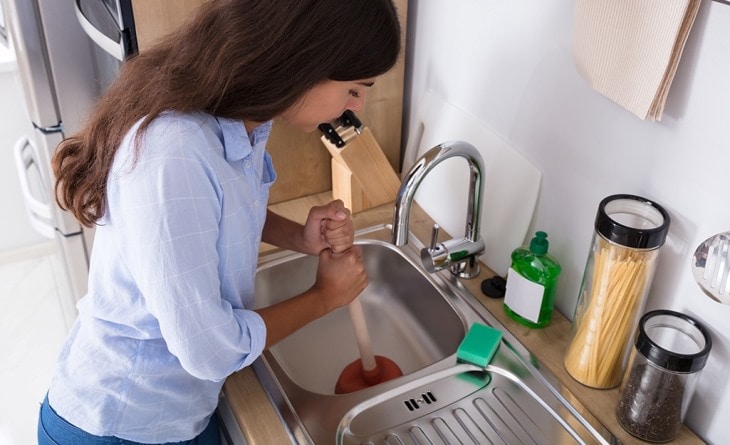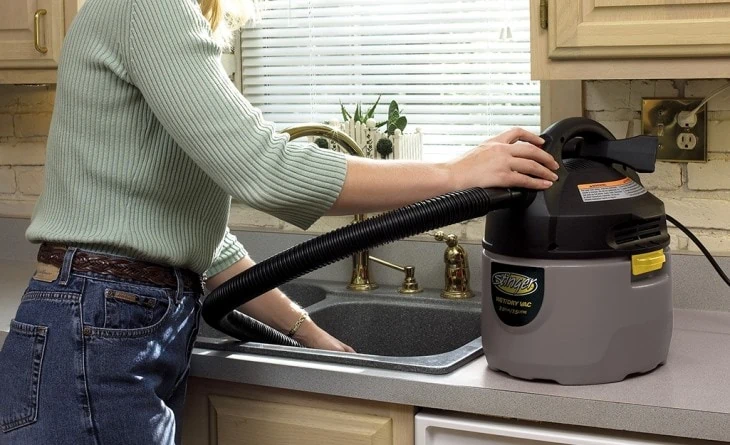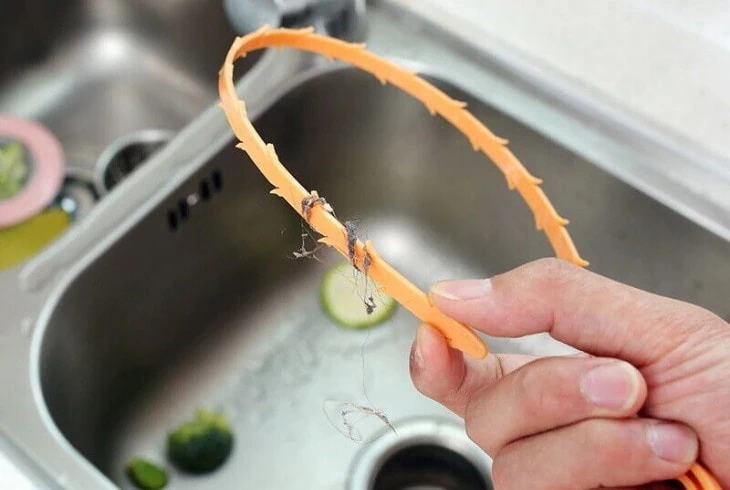We’ve all been there, standing at the sink, filled with frustration watching the remnants of dinner refusing to disappear down the drain.
But the truth is, you’ve emptied too many pots of coffee and pushed countless pieces of pasta through the strainer, and the drain has had enough.
To unclog your kitchen or bathroom sink when cleaning the p-trap isn’t enough, use either a baking soda vinegar mixture or a combination of a plunger, pipe snake, and wet vac. Once the pipe is unblocked, make sure you reconnect the various pipes and fittings you took off before ending the process by pouring a kettle of boiling water down the sink to remove any lingering food waste.
Table of Contents
Solution #1 – Mix Up a Baking Soda and Vinegar Solution

Try this method first, as it is simple and straightforward, and you are almost guaranteed to have these two ingredients in your kitchen.
Remove the Excess Water
Don’t run water into the sink you wish to unplug for about 2-3 hours prior. Let the excess water drain away.
Pour Out the Baking Soda
Once the drain has had time to empty, find some baking soda in your kitchen or shop online. Measure out a cup of baking soda and, using a funnel, pour it carefully down the drain.
If the sink you wish to unplug has more than one drain, don’t be afraid to pour the baking soda down both. Once in the drain, let it sit for 5-10 minutes.
Measure Out the Vinegar
After 5-10 minutes, take a cup of vinegar and pour it down the drain/ drains as well, using a funnel if needed. Wait another 5-10 minutes for the baking soda and vinegar to do their work.
What’s Going on Down There?
Maybe you are thinking that the baking soda and vinegar just magically eat up whatever is down there, clogging your drain. However, what is really going on is a chemical reaction between the two.
The Chemical Reaction
When the baking soda (a base) comes into contact with the vinegar (an acid), a reaction takes place, and molecules are changed. During the process, carbon dioxide and water bubble into the clog, breaking it apart.
You should see foaming and hear bubbling as the reaction takes place.
Wash It All Away
Now that the clog of food or hair is loose in the pipe, you need to wash everything away. Boil a full kettle of water and pour it down the drain.
Again, if the sink you are unplugging has more than one drain, pour the hot water down both just to make sure everything is washed away.
Solution #2 – Ply the Plunger

Want some good exercise while you unblock your drain? Use a plunger.
Find the Right Plunger and Seal It Properly
Place the plunger in the bottom of the sink, over the drain. Before you start plunging, make sure you have a good seal between the mouth of the plunger and the drain.
If your sink has an overflow drain, cover it with a damp rag or piece of tape to help seal, guaranteeing a more powerful plunge.
Fill the Sink
Fill the sink partially with hot water. Make sure the water is hot, as it water will help loosen things up down below.
Roll Up Your Sleeves and Start Plunging
With 5-6 swift, forceful strokes, press the plunger down and up. Repeat the process 6 times. Try and maintain a good seal throughout.
This repeated process will force the water down and up, taking with it the food and debris that are clogging your drain. Keep repeating the process, and you will succeed.
Pour a Kettle of Boiling Water Down
Once the water is draining properly, boil a kettle and pour the hot water down the drain. This will get rid of any last remnants of food waste that might still be there.
Solution #3 – Send in the Pipe Snake
Here’s another possible method to try when things are blocked downstream from the p-trap.
Where Do I Find One?
Ask a local plumber or purchase one online. Make sure you have the right one, as there are slightly different versions for toilets, showers, and sinks.
Remove the P-Trap
Put a bucket on the floor under the sink and carefully remove the p-trap so you can get at the pipes in the wall.
Unleash the Beast
Unroll the pipe snake and carefully fit the end into the pipe. Continue feeding the plastic cable into the pipe. Make sure you don’t force things.
When you do come up against the clog, push and retract the pipe snake into it. This movement will make the head wobble and loosen the blockage.
Reattach the Pipes
Once the drain is successfully unplugged, carefully pull out the pipe snake and reattach the p-trap. Make sure everything is tight, so the pipes and fittings are water-tight once the sink is in use again.
Send Down a Kettle of Boiling Water
As before, to ensure there is no residue left in the pipe, pour down a kettle of boiling water. You need to make sure the food waste you have just loosened is completely washed away.
Solution #4 – Suck Out the Blockage with a Wet/Dry Vac

If all else fails, locate a wet/dry vacuum, attach it to the pipe, and suck out the blockage.
How Does It Work?
A wet/dry vacuum cleaner has two chambers that separate the solids from the liquids. This allows it to suck up dirt, leaves, and even water.
Where Can I Find One?
Admittedly, a wet vacuum might be more difficult and expensive to find. However, you can ask your local plumbing service or buy one on Amazon.
Take Off the P-Trap
Take off the p-trap so you can get at the drain pipes in the wall.
Attach the Wet Vacuum
Take the hose and extend it down the mouth of the drain pipe. Turn the machine on and make sure the seal is good between the end of the hose and the pipe.
Let the Machine Do the Work
Once the machine is running, leave it for a few minutes, and it should be able to dislodge the clog. Once the pipe is unplugged, carefully remove the hose.
Reassemble the P-Trap
Remember to put the p-trap and any other fittings back together and ensure everything is watertight.
Hot Water to Finish
Lastly, pour some boiling water down the drain to get rid of any surviving scraps still down there.
Additional Tips to Unblocking the Drain Past the P-Trap
Think About What you Send Down There
When you are cleaning up from dinner, scrape off the plates so any extra food goes into the garbage, not the drain.
This might take an extra second to do, but it’s nothing compared to the hours you could spend trying to unblock your drain when it does plug up.
Watch Out for Certain Foods
Certain foods, such as pasta, oils, and coffee grounds, are more likely to clog up your drain past the p-trap. Take extra care to keep these out of the sink.
Tools That Will Help Keep the Pipes Clear

If you’re like me, then you’d probably prefer never to have to unblock the drain after the p-trap. To ensure this, buy yourself a plastic barbed drain-clearing tool and a basket strainer. Both of these will stop food from getting down past the p-trap.
Final Thoughts
Try one or all of these methods, and you will have a clean, free-flowing sink in your kitchen or bathroom. Remember, preventing a blockage from happening is as important as knowing what to do when the sink doesn’t drain. Be mindful of what you send down there!

